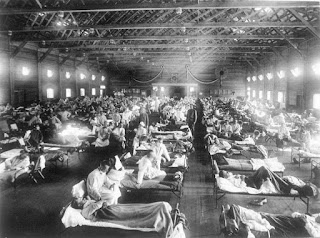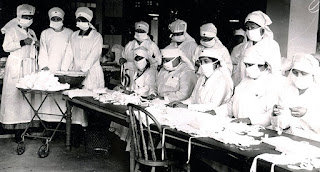- Get link
- X
- Other Apps
- Get link
- X
- Other Apps
The Deadliest Plague
 |
| Spanish Flu Microscopic Visual. |
Monday, March 11, 1918, at a military training facility at Kansas called Fort Riley around 26000 men were stationed there and on that particular day a mess cook named Private Albert Gitchell woke up feeling like hell. he had high fever his throat was sore, and his body ached all over. The men went to see a nurse and yes as you might guess the guy was burning like hell. He had a temperature of 103 degrees F (39.4 Celsius). Soon after Gitchel, one corporal Lee Drake visited the nurse with pretty much the same symptoms. Later Sargent Adolf Hurby was next to join the line, which keeps getting longer and longer.
'So can we say that Gitchel was the patient zero?' well that saying that is quite controversial but sicker and sicker American soldiers all over the country would head to the battlefields of Europe. That's the point where all the hell breaks loose.
Quick fact, before we get to know how dangerous and devastating this flu was, in view of what you read above you are probably wondering why it's called the 'Spanish flu' and not the 'Kansas flu', well as the origin of this flu was studied by many researchers for many years. During 1916 - 1917, in France, 100's of thousands of soldiers passed through a certain hospital camp. There, military pathologists reported a flu-like disease that had a high mortality rate. One seriously believed theory was that the disease was spread from the poultry at the camps first to the pigs and then to the humans. Other researchers postulated that it was started in Australia, or China, or some parts of East Asia or indeed the USA. So it might have been imported to Europe or originated in Europe, but the discussion is still going on. So the reason we call it the Spanish flu is mere because Spain's media wasn't heavily censored during wartime and so that country's newspapers made it look like Spain(neutral in the war) was the worst-hit country of all which wasn't true. The name seems to stick though, it should be called, "Not The Spanish Flu".
 |
| Army's Warning Boards |
This deadly flu travels fast and it's estimated that around 27 percent of the world's which is 1.8-1.9 billion people got infected. Well it's quite hard to get the exact number, and the estimate varies widely, but it's thought that the death toll of this flu was at least 50 million and maybe as much as 100 million and this number is even greater than the people died in World War 1. Nearly half a million people died around the USA itself, and the surprising fact is that young adults from their 20s to their 40s were the worst hit. To give that a prospective, in 1917 the life expectancy in the U.S. was 51 years and in 1918 was dropped to 39. The theory why the virus seemed to kill more people who you could say should have had the stronger immune system, those in the prime of their life is that a similar flu pandemic had happened some decades earlier but that flu wasn't quite as lethal. The survivors of that flu may have developed an immunity and so when the Spanish flu hit around they dealt with it better. As for not getting very young people, the theory is the flu had fewer effects on them.
This Spanish flu was virtually in every part of the world:-
- Talking about India, around 17 million people died, which is around 5% of our total population around that time.
- In the dutch east indies, around 1.5 million people died.
- Around 390,000 Japanese people scummed to this deadly disease.
- In Britain 250,000 flu deaths reported.
- In France, 400,000 people died because of this deadly virus.
- In Iran, the reported deaths were around 902,000 and 2,431,000.
Few places in the world were not hit by the flu and that is because they were so remote for example:-
- Islands in Fiji, in the south Pacific, called the Lau and Yasawa islands.
- Marajo island on Brazil's Amazon delta.
- Some parts of Alaska were also spared of the horrors of the pandemic.
So I am sure that till now you got the idea that the Spanish Flu wreaked havoc across all the four corners of the globe and was one of the most terrifying things that happened in the 20th century.
 |
| Treating facility for Spanish Flu treatments. |
How it spread so fast and why it couldn't be contained
Well, for one thing, infected soldiers living in close quarters in often terrible conditions, and those soldiers were traveling far and wide. The war was a 'world' war that involved many countries, some with empires and many colonies. It was believed that there was a first wave of the flu, but the second wave spread so fast because of wartime troop movements. The first wave was not that bad, more like the seasonal flu one might get easily those days but the second wave was fearsome, especially when the reports came in that young healthy people had come down with a fever and then were dead within 24 hours. The reason behind that was, in some cases the patient would first have a very high fever, next would come nasal hemorrhaging and pneumonia their lungs would fill with fluid and they would literally drown in that fluid. That time even doctors don't even have a slightest clue what's happening so they blamed the chemical warfare for this but we now know that there is a condition known as "Cytokine Explosion" which is basically an immune response from the body to help a person
when he or she has been attacked by a virus. But there could be an overreaction, and when the body sends too may messenger proteins called Cytokines this can create an explosion. The downside to this is inflammation and that fluid build-up in the lungs. This might also be the reason most people in their 20s and 40s died because their really strong immune system caused the biggest storms of Cytokine and their body overreacted.
"They are placed on the cots until every bed is full, yet others crowd in. Their faces soon were a bluish cast; a distressing cough brings up the blood-stained sputum. In the morning the dead bodies are stacked about the morgue like cordwood." these are the exact words of a U.S. surgeon general who witnessed the sight of a military hospital where hundreds of young soldiers were admitted and this is how he described the scene. Nowadays we have technologies to contain and isolate a virus, and because of this we can look at its genetic sequences and attempt to create antiviral drugs and even vaccines, but sadly we didn't have all that in 1918, and because the troops from around the world were mixing together and are going back to their hometowns and when people showed early signs of the disease and moved about in public it was hard to test them and so they weren't quarantined as they would be now. As of nowadays we have technologies like backtracking, etc to find out form whom one does get infected, more so doctors and health workers have protective kits, media is reporting daily updated for the public so we can counter such situations but none of that was there back in 1918 and people just can't go to the internet to work from home and the media isn't even covering that because it would have bad effects on the war, the only country who covered this pandemic was Spain, so that's why it got the name.
In Britain during the war the chief Medical officer of the local government board, Sir. Arthur Newshole, know very well that a lockdown could prevent further spread of the disease, but that was out of the question because of the war efforts. Those munitions factories and many other industries could not just stop.
| A team of nurses created for the Spanish Flu Treatment |
When you come down with this kind of flu, more could be effective. 9,000 trained white nurses were sent to Europe to help sick soldiers, and thousands more worked in U.S. military camps. But there weren't just enough of them given the size of the problem. More American soldiers died from flu than they did in the battle. There were African-American nurses ready to help the war efforts, but because they mostly graduated from small segregated hospital training schools, they were not utilized were American soldiers and civilians had the flu. This was sheer madness and not something that could ever happen in our modern world. But it's just another reason why Spanish flu was as deadly as it was. It was the same in the civilian hospitals in the U.S., which were also packed with flu victims, Black Nurses for the most were denied entrance. This is the reason why by August 1918 the U.S. civilian hospitals were left with minimal staff, not enough to meet the demands that would follow when flu patients flooded into hospital wards.
At the end of 1918 the cases just kept dropping until it seemed the Spanish flu pandemic was almost over. One theory is that medical professionals became better at dealing with it, but it's more likely that the strain of the disease just mutated into something less lethal. It wasn't until mid-way through 1919 that the Spanish Flu pandemic was said to be officially over. Other flu pandemics would come, but none as deadly as the Spanish Flu. It's actually sometimes called the "forgotten pandemic". Maybe even some of you had never heard of this devastating outbreak. The reason it was forgotten of course was that it happened during one of the bloodiest wars in history.
- Get link
- X
- Other Apps

Comments
Post a Comment